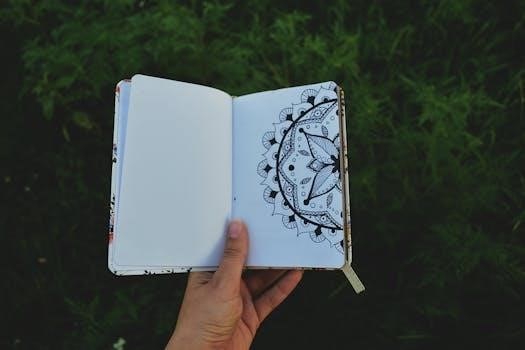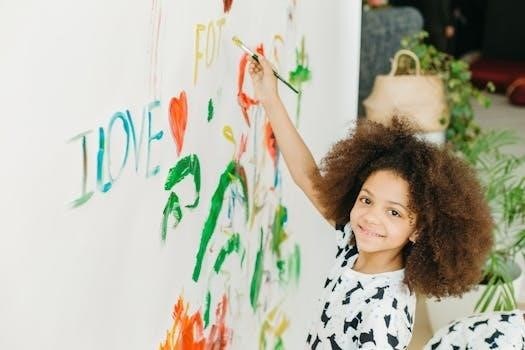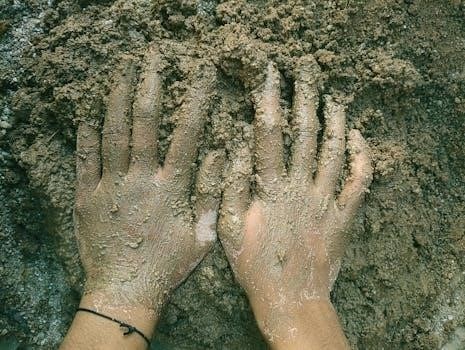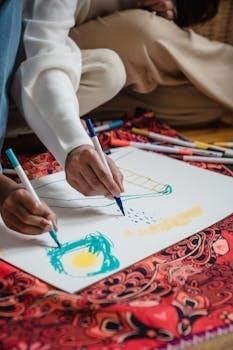expressive art therapy activities pdf

Expressive Arts Therapy utilizes diverse art modalities like visual art, music, movement, and writing. It promotes healing, psychological growth, and overall wellbeing through creative expression. This approach differs from traditional art therapy by integrating multiple art forms.
Definition and Scope of Expressive Art Therapy
Expressive Arts Therapy is a psychotherapeutic approach that intentionally integrates various art forms, including visual arts, creative writing, music, movement, and drama, to facilitate emotional, psychological, and physical healing. It goes beyond traditional art therapy by embracing a multimodal approach, recognizing that individuals can express themselves and process experiences through diverse creative channels. The scope of expressive arts therapy encompasses a wide range of settings, from individual therapy sessions to group work, and it addresses diverse needs, such as trauma recovery, stress management, self-discovery, and personal growth. It emphasizes the creative process and the individual’s unique responses to art materials, promoting self-awareness and facilitating emotional expression, thereby enhancing overall well-being and holistic integration.

Core Principles of Expressive Arts Therapy
The core principles revolve around the integration of multiple art forms to facilitate self-expression and healing. It emphasizes the inherent creativity and capacity for growth within each individual.
Multimodal Approach in Expressive Arts Therapy
The multimodal approach in Expressive Arts Therapy is a fundamental aspect that distinguishes it from other therapeutic modalities. It intentionally integrates various art forms, such as visual arts, music, dance, drama, and creative writing, within a single therapeutic process. This allows clients to explore their thoughts, feelings, and experiences through different expressive channels. By engaging multiple senses and creative modes, individuals can access deeper levels of self-awareness and emotional processing; This approach acknowledges that different art forms can resonate with different aspects of a person’s inner world, providing a more comprehensive and personalized therapeutic journey. The use of varied modalities offers flexibility, catering to diverse preferences and abilities, facilitating a more holistic and integrated experience of self-discovery and healing;

Modalities Used in Expressive Arts Therapy
Expressive Arts Therapy utilizes diverse modalities, including visual art, music, movement, and creative writing. These various forms of expression facilitate emotional exploration, promote self-discovery, and support the therapeutic process.
Visual Art Activities in Expressive Therapy
Visual art activities in expressive therapy offer diverse avenues for self-expression and emotional processing. These activities range from drawing and painting to sculpting and collage, allowing individuals to explore their inner world through non-verbal mediums. The focus is on the process of creation rather than the final product, encouraging freedom and spontaneity. Working with various materials like colored pencils, markers, pastels, and clay can evoke different sensory experiences and responses. Symbolism and imagery often emerge, providing insights into underlying emotions and experiences. These visual explorations can serve as a powerful tool for self-discovery and healing in a therapeutic context, allowing for a deeper connection with one’s feelings.
Movement and Dance in Expressive Therapy
Movement and dance within expressive therapy offer a unique pathway to explore emotions and experiences through the body. This modality facilitates non-verbal communication and can access feelings that are difficult to articulate through words. Activities may involve structured movements or free-form dance, allowing for spontaneous expression and exploration of physical sensations. Movement can help release tension, promote body awareness, and foster a sense of connection between mind and body. The emphasis is on the process of moving and experiencing, rather than achieving perfect steps or techniques. Through movement, individuals can discover new ways of relating to themselves and their emotions, leading to a greater sense of well-being and self-understanding.

Therapeutic Applications
Expressive arts therapy is utilized for diverse populations, offering creative outlets for emotional processing. It supports individuals dealing with trauma, stress, and seeking self-care, enhancing overall mental well-being.
Expressive Arts for Trauma and Stress
Expressive arts therapy offers a powerful, non-verbal approach for individuals grappling with trauma and stress, providing a safe space for emotional processing. Through modalities like visual art, movement, and music, individuals can externalize and explore difficult experiences without relying solely on verbal communication. This approach can be particularly beneficial when words feel inadequate or unsafe. The creative process can facilitate emotional release, promote self-regulation, and help individuals develop coping strategies. Activities are designed to be gentle and trauma-informed, ensuring a sensitive and supportive environment. This approach helps in restoring emotional balance and fostering a sense of empowerment and resilience by allowing individuals to explore their feelings and experiences through different creative mediums. Expressive art can become a pathway to healing and regaining a sense of control.
Expressive Arts for Self-Care
Integrating expressive arts into self-care routines can significantly enhance emotional wellbeing and promote relaxation. Engaging in activities like drawing, painting, or simple movement exercises can offer a healthy outlet for stress and tension. These practices can help individuals connect with their inner selves, explore emotions, and cultivate a deeper understanding of their feelings. This approach is accessible to everyone, regardless of artistic skill, as the focus is on the process rather than the outcome. Incorporating expressive arts promotes mindfulness, allowing individuals to be more present and attuned to their experiences. It fosters creativity, encourages self-discovery, and provides a fun and fulfilling way to prioritize mental and emotional health. The use of various art forms offers different avenues for self-expression, making it a versatile self-care tool. These simple activities can be transformative.
Theoretical Approaches in Expressive Arts Therapy
Expressive arts therapy draws from various psychological theories, including psychodynamic, humanistic, and Gestalt perspectives. These approaches help explain how creative processes facilitate healing and self-discovery within a therapeutic context.
Psychodynamic Concepts in Expressive Therapy
Psychodynamic concepts significantly influence expressive arts therapy, exploring the unconscious through creative mediums. This perspective utilizes art as a means to access repressed emotions and unresolved conflicts, mirroring the principles of traditional talk therapy. The application of psychodynamic theory within expressive therapy often incorporates techniques like free association, where clients create art without conscious censorship, allowing deeper emotional content to surface. Symbolism within the artwork is meticulously examined, providing insights into underlying psychological patterns and defense mechanisms. Therapists analyze the manifest and latent content of creative productions, facilitating a deeper understanding of the individual’s inner world. This approach underscores the belief that art can act as a powerful tool for self-discovery, emotional processing, and personal transformation, all within the framework of psychodynamic theory.

Practical Techniques and Activities
Expressive arts therapy employs various techniques, such as mindful exploration of diverse art materials. Line drawing exercises can also enhance present moment awareness, promoting self-discovery through creative expression.
Line Drawing and Present Moment Awareness
Line drawing serves as a powerful tool in expressive arts therapy, facilitating a return to the present moment. This technique encourages individuals to focus on the immediate experience of creating lines on paper, fostering mindfulness. The simplicity of line drawing allows for a direct connection with the creative process, minimizing self-judgment and promoting a sense of flow. By engaging with the physical act of drawing, one can become more attuned to their thoughts, feelings, and bodily sensations in the here and now. It provides a gentle and accessible entry point for exploring emotions and thoughts through non-verbal expression. This practice can help to ground individuals and reduce feelings of anxiety or overwhelm, by focusing their attention on the simple act of creating lines. Line drawing also fosters a meditative state, supporting self-regulation and inner calm.
Mindful Exploration of Art Materials
Mindful exploration of art materials is a core practice in expressive arts therapy. This involves engaging with various media such as colored pencils, markers, pastels, watercolors, clay, and collage in a sensory-focused manner. The emphasis is on experiencing the texture, smell, and visual qualities of the materials, fostering heightened awareness of sensory input. This process helps to cultivate a deeper understanding of personal responses to different stimuli, offering insights into emotional states. By paying attention to the interaction with materials, individuals can access a deeper connection to their inner world. The materials act as a secret key, unlocking pathways to self-discovery. This approach can also introduce the concept of symbols and images as a reflection of emotional and physiological responses to stress or trauma, making these abstract concepts more tangible.